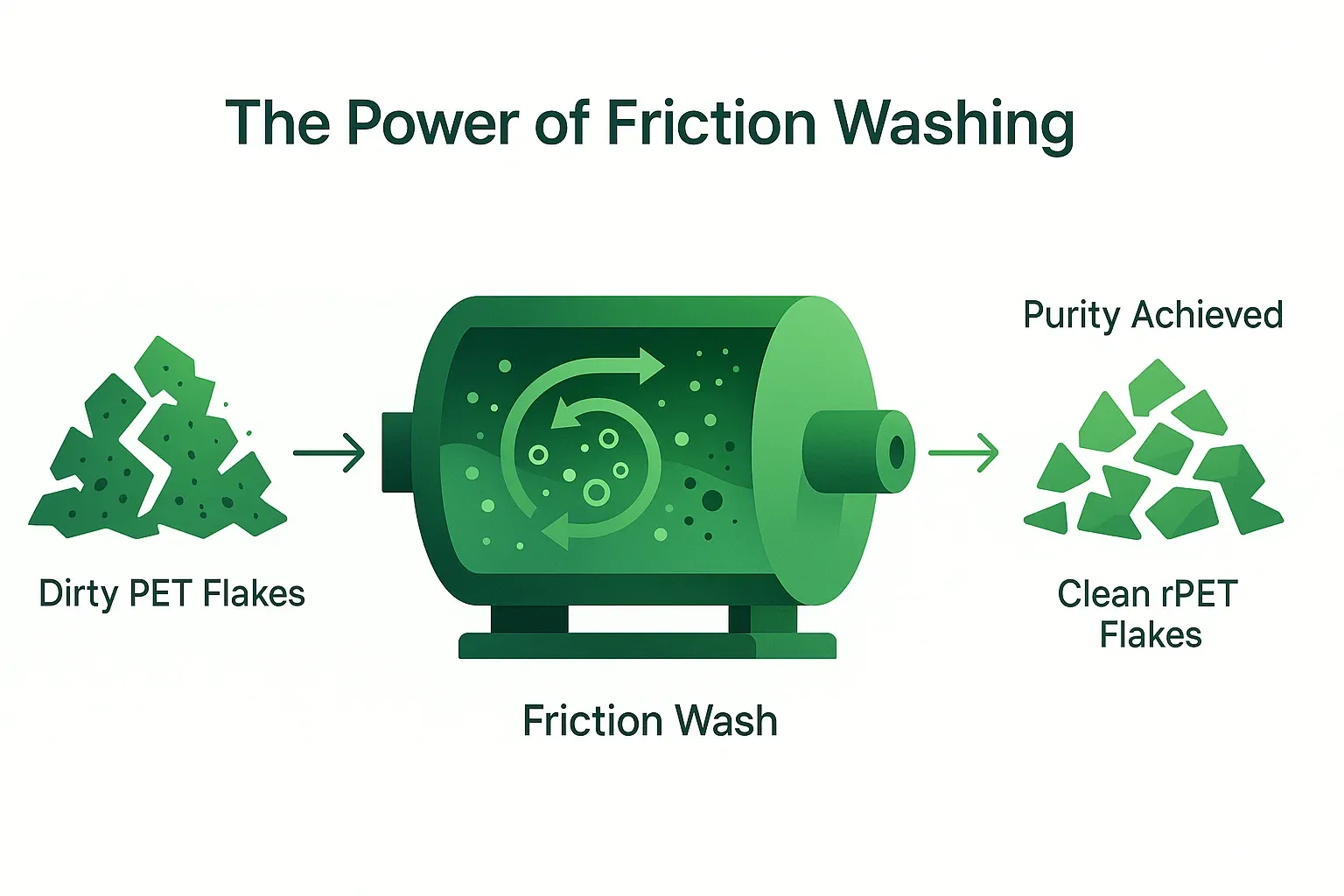Unlocking Purity: The Power of Friction Washing in PET Bottle Recycling
Welcome, procurement specialists, engineers, and technical experts! If you’re involved in PET bottle recycling, you understand the critical importance of producing high-quality recycled PET (rPET). One of the unsung heroes in achieving this purity is friction washing technology. Let’s dive into how these dynamic systems elevate the efficiency and output of a modern macchina per il riciclaggio delle bottiglie in pet.
What Exactly is Friction Washing?
At its core, friction washing is an intensive cleaning process designed to remove stubborn contaminants from shredded or flaked plastic materials, particularly PET. Imagine a high-speed washing machine, but engineered specifically for plastics. This technology utilizes mechanical friction, water, and sometimes detergents to scrub away impurities.
Key components typically include:
- A high-speed rotor or auger: Equipped with paddles or specially designed blades, this is the heart of the friction washer, creating intense agitation.
- A cylindrical or V-shaped trough/housing: Contains the material and water.
- A screen or perforated cage: Surrounds the rotor, allowing water and dislodged contaminants to escape while retaining the PET flakes.
- Water inlet and outlet ports: For continuous flow and removal of dirty water.
The principle is simple yet effective: PET flakes are fed into the machine where they are vigorously agitated by the rotor. This high-speed action causes the flakes to rub against each other, the rotor, and the screen. This inter-particle friction is highly effective at dislodging labels, adhesives, dirt, food residues, and other surface contaminants.
Why is Friction Washing Indispensable in PET Recycling?
The journey of a PET bottle from waste to a valuable raw material is complex. Friction washing plays a pivotal role in several stages, ensuring the final rPET meets stringent quality standards for applications like bottle-to-bottle recycling, fiber production, or strapping.
1. Superior Contaminant Removal
While pre-washing and float-sink tanks remove gross contaminants and separate materials by density, friction washers target the more tenacious, adhered impurities. This includes:
- Paper and plastic labels: Shredded labels can be stubbornly attached.
- Adesivi: Glues used for labels are notoriously difficult to remove.
- Fine dirt and sand: Embedded in crevices or electrostatically clinging to flakes.
- Organic residues: Remnants of beverages or food products.
Effective removal of these contaminants is non-negotiable for high-quality rPET. Even small amounts can cause defects, discoloration, or odor in the final product.
2. Enhancing rPET Purity and Value
The cleaner the PET flake, the higher its market value and the broader its range of potential applications. Friction washers contribute directly to achieving the purity levels required for food-grade rPET, which commands a premium price. This focus on quality is essential for a sustainable circular economy for plastics.
3. Optimizing Downstream Processes
Cleaner flakes entering subsequent stages like hot washing or drying reduce the load on those systems. For instance, by removing a significant portion of organic matter, friction washers can reduce the chemical consumption in hot washing units and improve the efficiency of wastewater treatment.
Key Operational Aspects and Considerations
To maximize the effectiveness of a friction washer within your macchina per il riciclaggio delle bottiglie in pet line, several parameters are crucial:
- Rotor Speed (RPM): Higher speeds generally mean more intense friction, but excessive speed can lead to flake degradation or unnecessary energy consumption. Finding the optimal RPM for your specific material and contamination type is key.
- Water Flow Rate: Sufficient water is needed to carry away dislodged contaminants. However, excessive water use increases operational costs and wastewater treatment burden. Modern designs often incorporate water recycling systems.
- Screen Hole Size: The perforations in the screen must be small enough to retain PET flakes but large enough to allow contaminants and dirty water to pass through efficiently.
- Angle of Incline (for some models): Some friction washers are inclined to control the residence time of the material within the unit.
- Material Throughput: Overfeeding the machine can reduce cleaning efficiency, while underfeeding can lead to underutilization.
Regular maintenance, including screen cleaning and inspection of rotor paddles, is also vital for sustained performance.
Integrating Friction Washers into the Recycling Line
Friction washers are rarely standalone units. They are strategically placed within a comprehensive PET bottle recycling line, typically:
- After primary size reduction (crushing/shredding): The material needs to be in flake form for effective friction washing.
- Before or after float-sink separation: Depending on the line design, they can be used to clean mixed plastics before density separation or to polish the PET fraction after separation.
- Often preceding a hot wash system: To remove a bulk of the contaminants and reduce the chemical and thermal load on the more energy-intensive hot wash.
The synergy between friction washing and other cleaning stages, like hot chemical washing and rinsing, is what ultimately delivers exceptionally clean rPET flakes.
The Future: Advancements in Friction Washing
Manufacturers are continuously innovating to improve friction washer designs. Trends include:
- Enhanced rotor and paddle designs: For more efficient scrubbing action with less material degradation.
- Improved water efficiency: Integrated water filtration and recycling systems to minimize consumption.
- Modular designs: For easier integration, maintenance, and scalability.
- Smart controls: Automated adjustments of parameters like rotor speed and water flow based on material input and contamination levels.
Conclusion: A Vital Technology for a Circular Economy
Friction washing technology is a cornerstone of modern PET bottle recycling. Its ability to meticulously clean PET flakes by removing stubborn surface contaminants directly translates to higher quality rPET, enhanced operational efficiency, and greater sustainability. As the demand for high-grade recycled materials grows, the role of advanced friction washers in a macchina per il riciclaggio delle bottiglie in pet setup will only become more significant.
Investing in the right friction washing equipment is an investment in the quality of your output and the future of plastics recycling. For more insights into complete recycling solutions, we invite you to explore our range of Macchine per il riciclaggio di bottiglie in PET.



